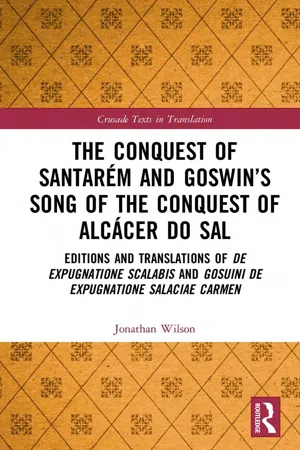
The Conquest of Santarém and Goswin's Song of the Conquest of Alcácer do Sal
Editions and Translations of De expugnatione Scalabis and Gosuini de expugnatione Salaciae carmen
- 184 pages
- English
- ePUB (mobile friendly)
- Available on iOS & Android
The Conquest of Santarém and Goswin's Song of the Conquest of Alcácer do Sal
Editions and Translations of De expugnatione Scalabis and Gosuini de expugnatione Salaciae carmen
About this book
Achieved at the height of the Crusades, the Christian conquests of Santarém in 1147 by King Afonso I, and of Alcácer do Sal in 1217 by Portuguese forces and northern European warriors on their way by sea to Palestine, were crucial events in the creation of the independent kingdom of Portugal. The two texts presented here survive in their unique, thirteenth-century manuscript copies appended to a codex belonging to one of Europe's most important monastic library collections accumulated in the Cistercian abbey of Alcobaça, founded c. 1153 by Bernard of Clairvaux. Accompanied by comprehensive introductions and here translated into English for the first time, these extraordinary texts are based on eyewitness testimony of the conquests. They contain much detail for the military historian, including data on operational tactics and the ideology of Christian holy war in the twelfth and early thirteenth centuries. Literary historians too will be delighted by the astonishing styles deployed, demonstrating considerable authorial flamboyance, flair and innovation. While they are likely written by Goswin of Bossut, the search for authorship yields an impressive array of literary friends and associates, including James of Vitry, Thomas of Cantimpré, Oliver of Paderborn and Caesarius of Heisterbach.
Frequently asked questions
- Essential is ideal for learners and professionals who enjoy exploring a wide range of subjects. Access the Essential Library with 800,000+ trusted titles and best-sellers across business, personal growth, and the humanities. Includes unlimited reading time and Standard Read Aloud voice.
- Complete: Perfect for advanced learners and researchers needing full, unrestricted access. Unlock 1.4M+ books across hundreds of subjects, including academic and specialized titles. The Complete Plan also includes advanced features like Premium Read Aloud and Research Assistant.
Please note we cannot support devices running on iOS 13 and Android 7 or earlier. Learn more about using the app.
Information
Part I
De expugnatione Scalabis
Date of redaction
Table of contents
- Cover
- Half Title
- Series Page
- Title Page
- Copyright Page
- Dedication Page
- Contents
- List of figures
- List of maps
- Acknowledgements
- List of abbreviations
- General introduction
- Part I De expugnatione Scalabis
- Part II Gosuini de Expugnatione Salaciae Carmen
- Appendix I: Inscribed text, Alc.415 fol. 146v
- Appendix II: Maps
- Bibliography
- Index